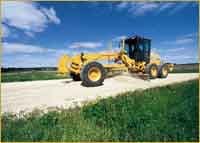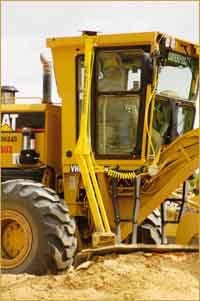Cat's alliance with Trimble makes satellite control of blade position a dealer installed option. The global positioning system can fix the blade's latitude, longitude and elevation and the grade-control computer automatically adjusts blade position until it matches a digital map of the desired grades. Komatsu recently forged an alliance with Topcon to offer similar technology.
- Average Motor Grader Costs
- Mainline Grader Specifications (by weight)
- Komatsu
- John Deere
- New Holland
- Case
- Volvo
- Caterpillar
- Noram
- Champion
- Leeboy
- PSI
Motor graders may be the sports car of the earthmoving world. If there's a technology that can improve their performance, there are plenty of buyers who will pay for it. Better final grades translate directly into lower materials costs on projects. So high-tech gadgetry like variable horsepower, hydrostatic front-wheel drive, and automatic grade control are common, if not always standard features on today's motor graders.
The number of manufacturers building graders hasn't changed much, but the competition at this vanguard of earthmover refinement has nonetheless intensified. Several pillars of equipment manufacturing recently asserted their expertise with motor graders—like when Dodge introduced the Viper and Ford resurrected the Cobra. Komatsu finally replaced the Galion brand with its own name, and CNH launched graders for its Case and New Holland brands. Volvo bought Champion in 1997 to add graders to the industry's newest full line of earthmovers.
Movement by the big nameplates into motor-grader manufacturing is keeping grader technology advancing briskly. An early example of this technology race is variable horsepower. Electronic fuel injection became necessary to satisfy the exhaust-emissions limits for off-road diesels, and variable horsepower (VHP) takes advantage of the computer that controls fuel injection. This electronic brain can be programmed to produce lower horsepower with a unique torque curve to control wheel slip at lower speeds. Performance parameters change in the higher gear ranges, and the engine generates greater maximum horsepower with a different torque curve for better efficiency and hill-climbing power.
A machine with VHP can deliver lots of controlled power when using the inching pedal to finish fine grades, and it can also push a huge head of snow down the road with a V plow and wing plow. This selective power generation is a standard feature on machines in Volvo's B Series and Komatsu Laterra graders. And while VHP is an option on competitive Caterpillar, John Deere, Case and New Holland models, it's typically priced to be easily accessible—about $2,200, for example on a machine with a manufacturer's suggested retail price of more than $230,000.
On-board computers are managing six-wheel power, too. Variable-horsepower machines are often programmed to increase engine power when front-wheel drive is switched on so there's no reduction in torque. Deere and Cat's systems coordinate front-wheel power with the tandems when inching. Volvo automatically disconnects power to the rear wheels when the operator is using the inching pedal, so the tandems freewheel over the finished grade.
Front-wheel drive is hydrostatic, and some systems are designed with dual circuits. The right front and left front wheels are powered and controlled independently, each by its own pump and motor, and each monitored by a speed sensor. They don't rob power from one another, and the computer can synchronize their output with the rear tandems. Cat, Deere and Volvo include switches in the cab of six-wheel-drive graders that allow an operator to dial in the aggressiveness of front-wheel drive to match the job conditions.
Deere reports that its 672CH II with standard six-wheel drive generates more than 39,000 pounds of blade pull—nearly 15,000 pounds more than the 670CH II with the same VHP engine. The all-wheel-drive model weighs 1,600 pounds more and the 60 percent increase in pull comes at a $33,000 price premium (about 17 percent).
The way a grader delivers rim pull is important, but the machine's greatest value remains in its ability to deliver accurate finished grades. High-tech grade systems have assumed significance that rivals power-train advances. Komatsu America formed an alliance with Topcon to outfit equipment with grading systems utilizing the global positioning system (GPS).
Caterpillar forged the first of such agreements with Trimble. Of course, grading technologies by Trimble, Topcon, Leica and any others can be retrofit to most machines. But Cat introduced the industry to grade controls integrated by the manufacturer, and Komatsu's subsequent move suggests that many buyers want the technology to be installed and supported by the OEM and its dealers. As a purchase option, the systems can be financed easily as part of the grader.
A number of grade-control options can be applied to motor graders, or the blade on virtually any other machine. The highest of tech starts with a digital map, or model, of the finished grades designed for a project. This immense database of the specific elevation for every point of latitude and longitude on a site is programmed into the grade-control computer. An antenna is mounted on each end of the machine's blade. A transmitter in the grader communicates through these antennae with satellites orbiting the Earth. The satellites' primary function is to fix the exact latitude, longitude, and elevation of the antennae. This global positioning system helps determine the cutting edge's current elevation and angle, and the grade-control computer compares that to the desired elevations on the digital project map.
Grade-control systems can act as an indicator—providing information the operator uses to decide if he should cut or fill. Or the grade-control computer can be networked to the hydraulic-system computer to automatically adjust the blade position as the grader moves over the site. It can bring the cutting edge to within one-tenth of a foot (20 to 30 millimeters) of the finished grade.
The systems nearly eliminate the need for conventional grade stakes and reduce the need to rework grades to meet specifications. Komatsu claims the Topcon system can cut grading time by as much as 60 percent.
Georgia-based grading contractor, Graham BROS, has been using Trimble's SiteVision GPS grade-control system for 2 years and has SiteVision installed on 29 pieces of heavy equipment, including graders, dozers, scrapers, excavators and soil compactors. The company has graded about 8,000 acres over the past 2½ years for what is expected to be the largest golf community in the United States. They will grade about 24,000 acres by the time the project is completed in 2007, setting the stage for 216 golf holes and associated development.
"Without the Trimble GPS system, we would lose 40 percent of our production," says Tommy Graham, chief surveyor and GPS coordinator for Graham BROS. "We need every advantage available to us."
At this end of the motor-grader market—where contractors need refined earthmoving power to quickly produce precise grades—motor-grader sales present dealers and manufacturers with attractive profit potential. Time will tell if the opportunity is great enough to justify three major manufacturers' (Komatsu, Volvo and CNH) investments in developing grader lines.
Perhaps equipment manufacturers see graders like sports cars, too. Just as the beauty and speed of a Corvette is expected to improve the perception of quality for all Chevrolets, so the performance and sophistication of a grader might raise customer expectations of other earthmovers carrying the same brand. Whatever the reason, it's good to see graders are on the cutting edge of earthmoving technology.
| Web Resources | ||
| Case www.casece.com |
||
| Caterpillar www.cat.com |
John Deere www.deere.com |
|
| Komatsu www.komatsuamerica.com |
LeeBoy www.leeboy.com |
|
| New Holland www.newhollandconstruction.com |
Volvo www.volvoce.com |
|
| PSI www.askpsi.com |
||






